
Creating an award winning mobile platform for third-party rental car insurance.
Role: UX designer • UX strategist • Information architect
Timeframe: 3 week sprints
Tools: Sketch • Axure • Invision
Deliverables: Annotated wireframe • Axure prototypes • Competitive analysis • Task flows • Proto personas
Founded in 2017, Bonzah has already become the front runner of the rental car insurance industry. In our kick-off meeting with Steve, the founder of Bonzah, we noticed that 65% of bonzah’s sale is generated by its return customers. We saw an opportunity to build a native mobile app that will help Bonzah to grow bigger in the future. In collaboration with our client, we set 3 high-level objectives to guide us moving forward.



After synthesizing data and insights from our research, we wanted to hone in on a specific problem to guide our design. But before we moved onto the next step we met with our client to ensure that we were aligned on the objectives. We asked our client to get in the mindset of a designer and defined what he sees as the most important problem users had. Being able to exam the overlaps among our insights helped us prioritize our focus for the next 2 weeks of designing and testing.
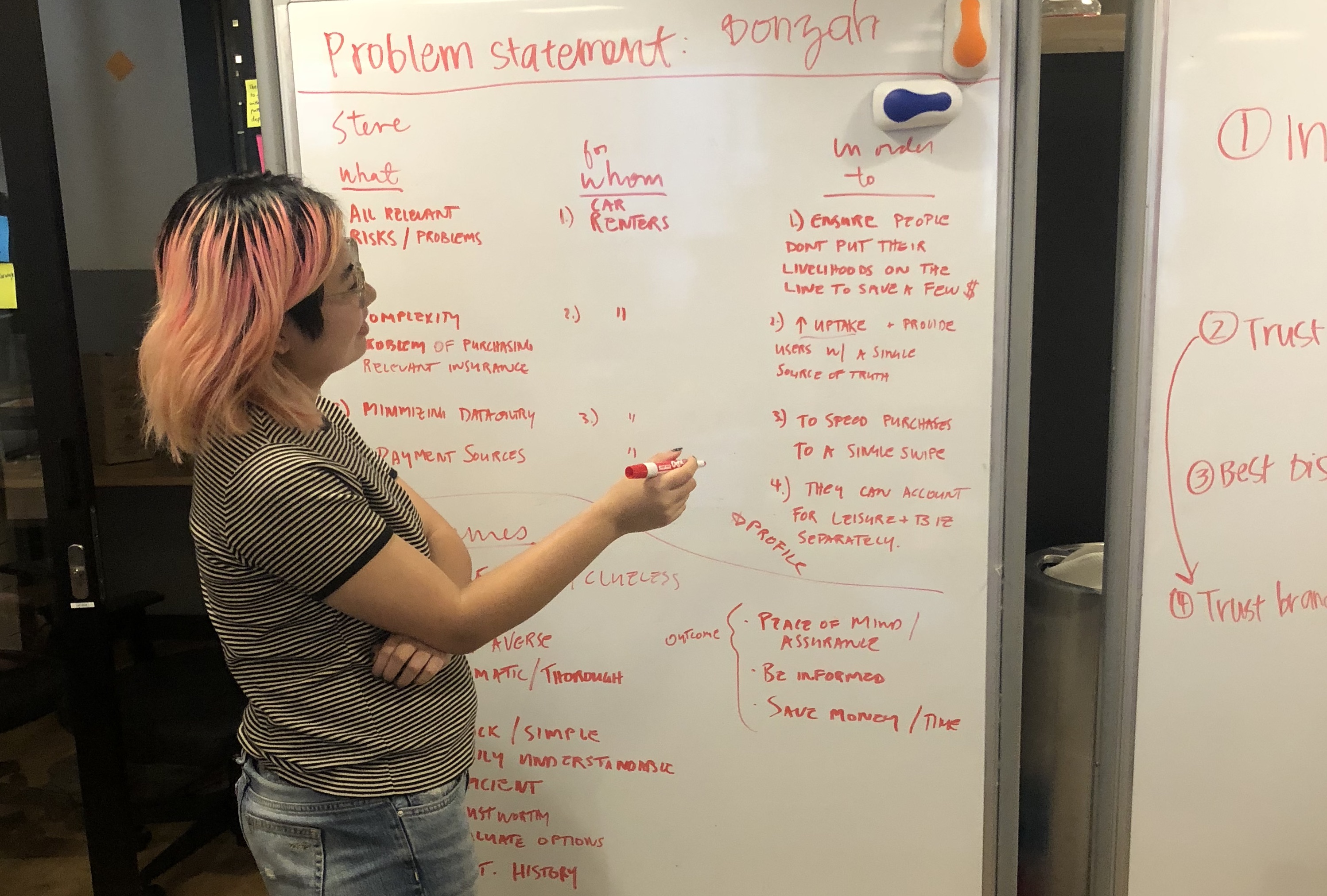
Click image to see the overlaps
The problem statement exercise with our client was very important because being an advocate of the users, we, UX designers, don’t often take business constraints into consideration. I believed it’s very essential to leverage the client’s expertise and knowledge when developing a product. We weighed in on our research findings and client’s objectives and defined the problem statement.
Insurance offered at the car rental counter is confusing and overpriced. Renters who decline coverage risk the chance of a costly accident that can negatively impact their primary insurance.
Frequent car renters need an app to help them understand rental policies at a glance so they trust the competitive value of Bonzah’s coverage.
We also sketched 3 design principles that help us measure our design:
Break down the complex insurance coverage information into organized sections to make sure users understand Bonzah’s value.
Make Bonzah feel more like a trustworthy friend than an insurance broker by keeping information close-at-hand and using friendly language.
Complete task in as few steps as possible. Take out extraneous flows and make the process straightforward.
We conducted an A/B testing with our Homepage designs and found that most users prefer to see their account information first. Even though it added an extra step to the purchasing process, our design promoted a sense of trust and friendliness by not being 'pushy' with selling policies.
Our designs also incorporated an itemized breakdown of coverage and used icons to help users understand their policies and make faster decisions.
I designed multiple access to customer service(phone&chatbot) to ensure that users could get help right way when they get in an accident.
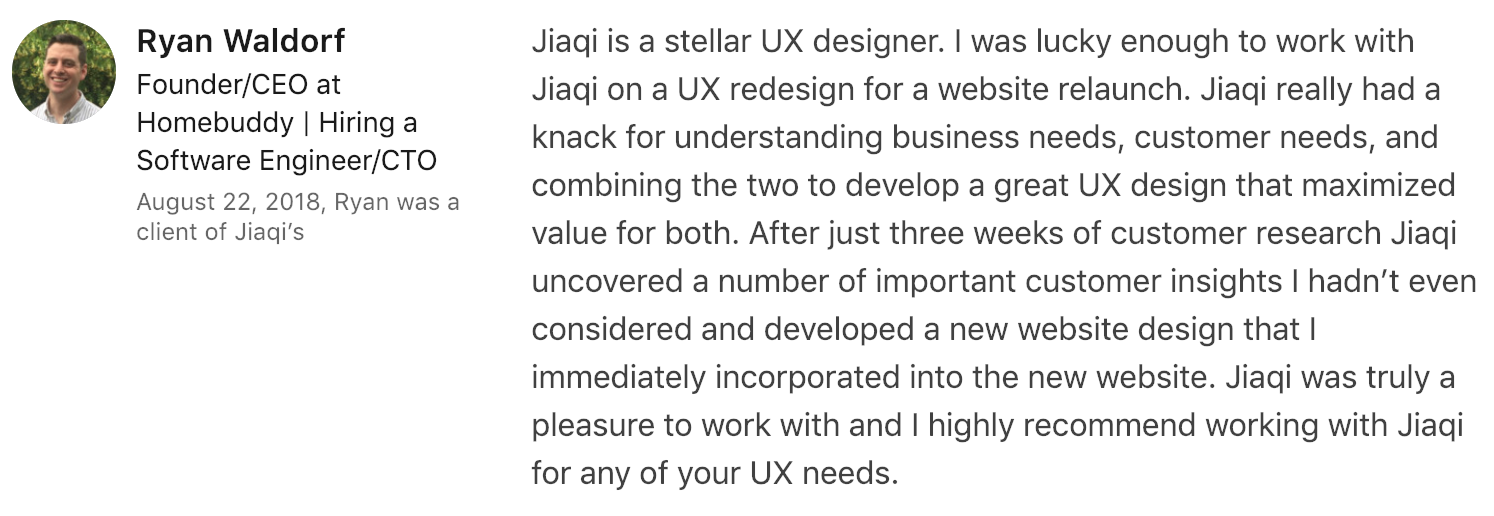

In our first kickoff meeting, we discussed our assumptions and questions about the current product with the client. We wanted to understand the intention of having a 3-step onboarding and having users input their availability for scheduling a professional. We asked our client to walk us through the current user journey of Homebuddy so we could understand his intention within the context.
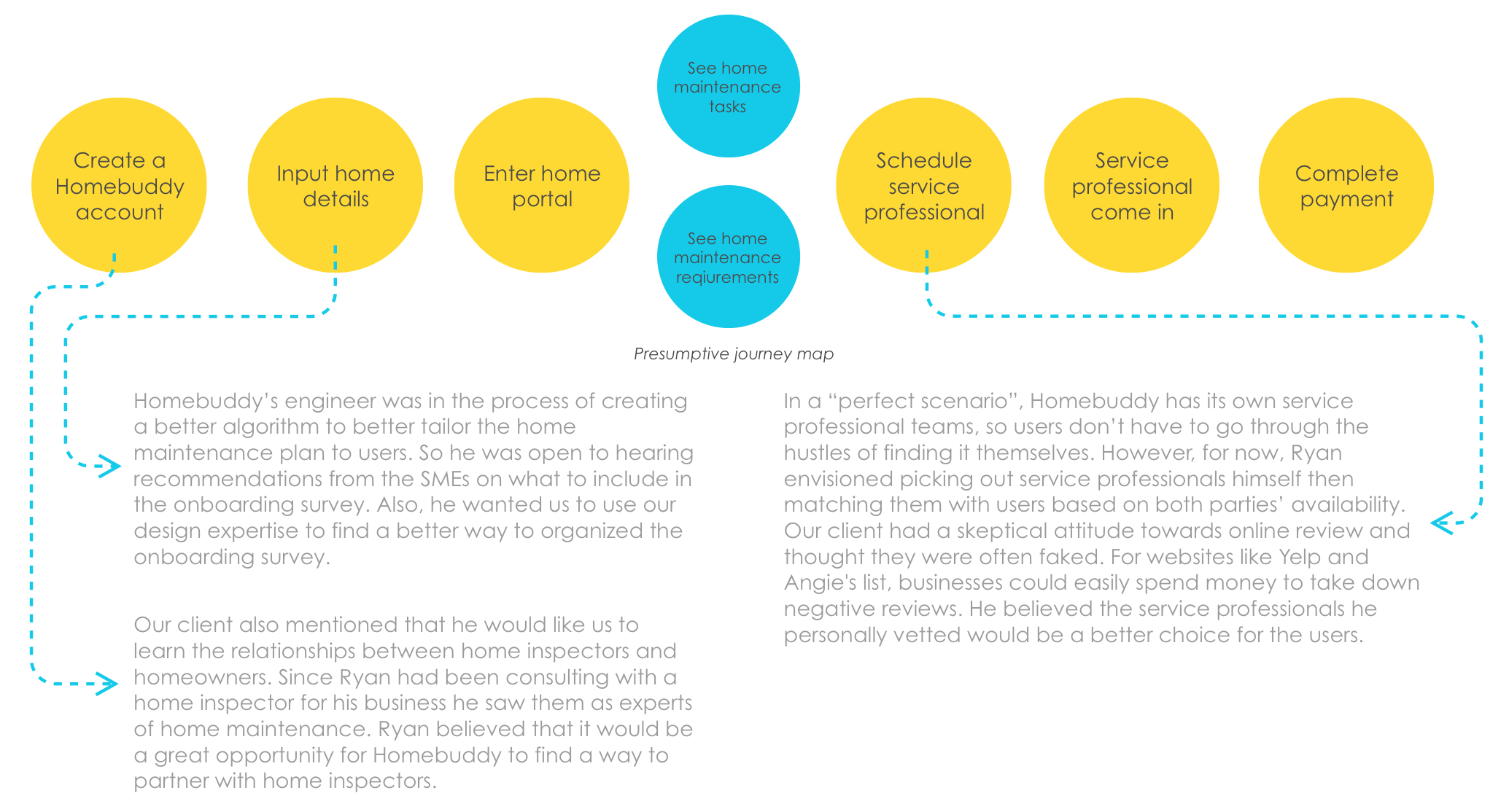
Walking through the assumptive customer journey with Ryan made me realize there was some ambiguity and flexibility around Homebuddy’s mission. Since Homebuddy didn’t have a proven business model we needed to confirm our client’s assumptions along with our research. I saw the ambiguity and flexibility as an opportunity for us. I thought it was very important to conduct preliminary marketing research besides user research.
Without any previous knowledge of home maintenance, I found it hard to grasp the users’ mental model on doing home maintenance. My last project Bonzah was also about doing preventive measures. I thought it was especially important to understand what motivates users to do preventive measures in the first place. Specifically, I wanted to know how homeowners approach doing maintenance himself and how users evaluate maintenance providers.
I learned from initial desktop research that “home maintenance" often referred to preventive home maintenance such as gutter cleaning, changing air conditioning filters and HVAC system check-ups. A home operates with the seasons, coming to life in the spring and hunkering down for the winter. Home maintenance tasks were generally broken down seasonally and geographically.
Home maintenance checklist like this were handed out by realtors as promotional materials. People put them on their fridge as their primary method to tackle home maintenance tasks.
We discovered that:
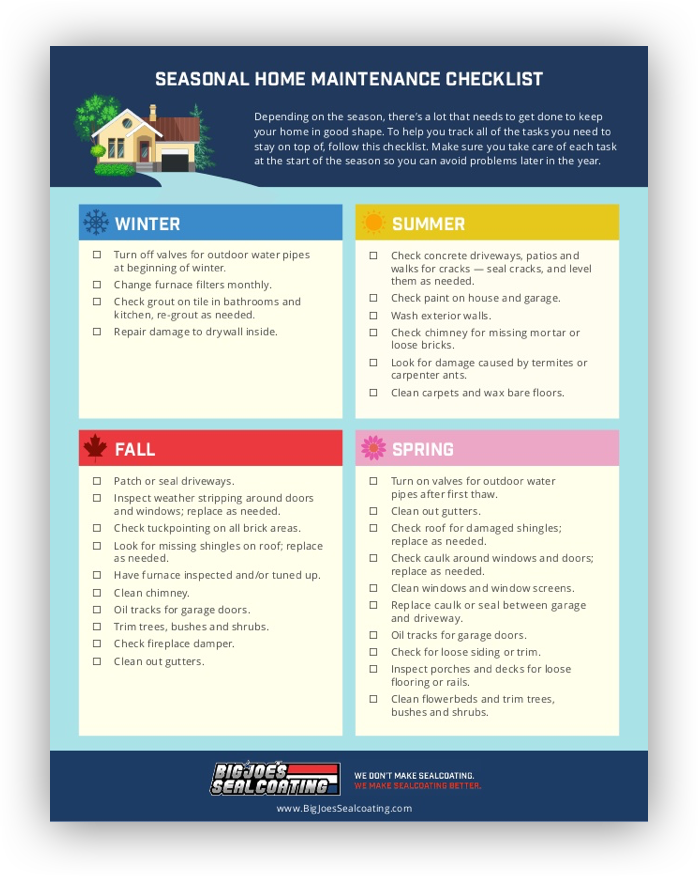
90% of homeowners believed they are doing an “okay” job of protecting their home yet 64% of them failed to update they maintenance plan.
The mismatch between people’s confidence and behavior might be the reason people ignore regular home maintenance.
The cost, time spend and difficulty of the task were the major deciding factors.
The finding helped me understand the criteria users need to choose between DIY and hiring a professional.
91% of people regularly or occasionally read online reviews, and 84% trusted online reviews as much as a personal recommendation.
People trusted reviews and expected to see reviews of the products. Even though our client thought not incorporating reviews would minimize the efforts to schedule a service professional, our research showed that reviews were crucial on choosing a service professional.
Considering Homebuddy was a new product, we wanted to first take a look at the current market and to identify any gaps and opportunities. We looked at HomeBinder, Porch, HomeZada, HomeSpot, and Dwellbeing who all offer some sort of home maintenance plan for users.
While comparing those features with the competitors, one competitor stood out to us: Dwellbeing, a free-to-use product, powered by Liberty Mutual Insurance. It seemed to do what everything Ryan envisioned for Homebuddy. Even though it was still in beta, it already had both mobile and website platforms and a more refined interface.
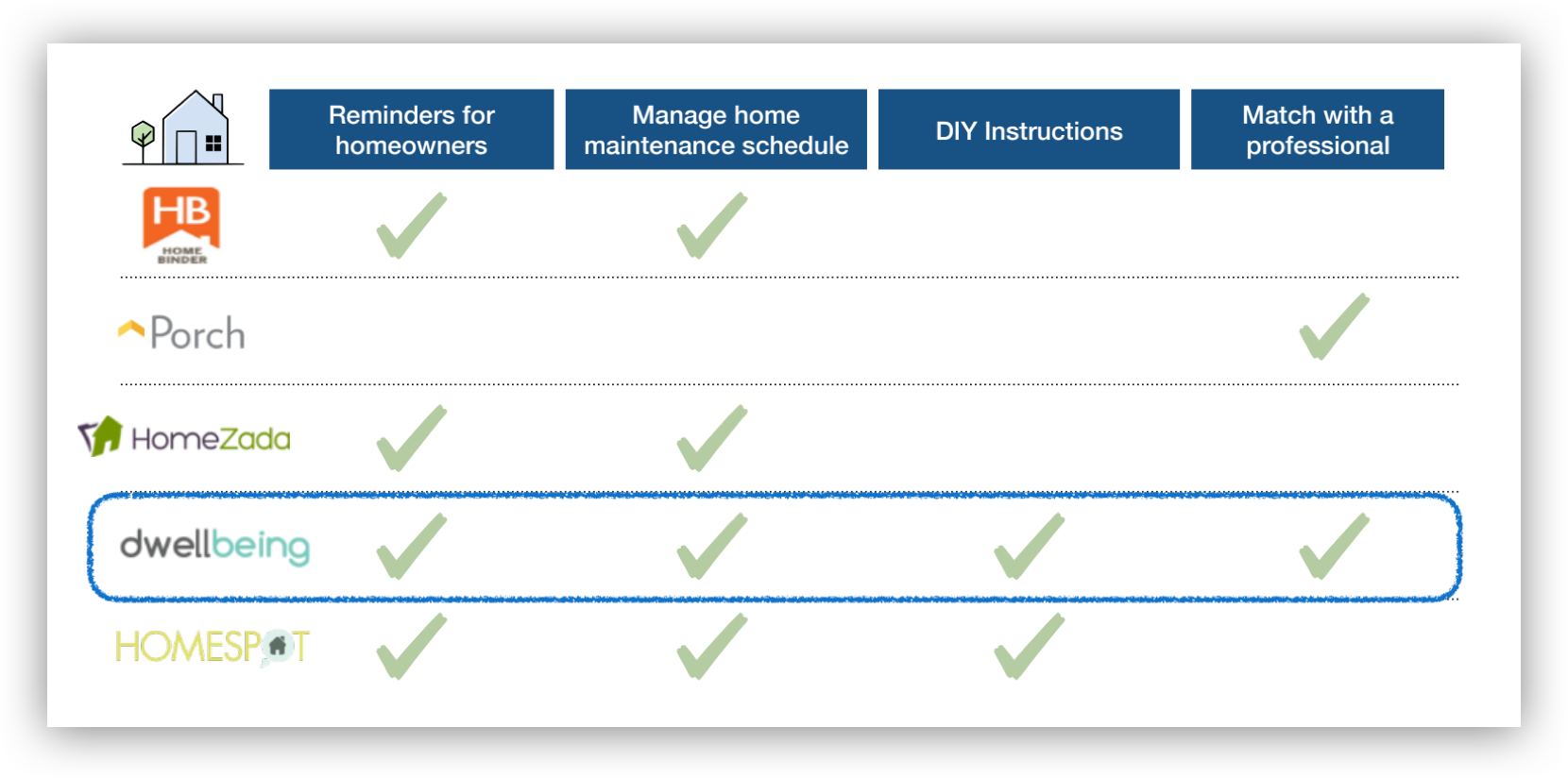
This discovery grabbed our attention. However, with further research, we found out that Liberty Mutual used Dwellbeing to gather home information to better assess their insurance rate. In the age of data privacy, my team thought this could be a down point for many users. We also discussed with our client about strategies that could differentiate Homebuddy and Dwellbeing. Our client didn’t see it as a threat because he believed honesty and sincerity would help Homebuddy stand out in the market.
This discovery grabbed our attention. However, with further research, we found out that Liberty Mutual used Dwellbeing to gather home information to better assess their insurance rate. In the age of data privacy, my team thought this could be a down point for many users. We also discussed with our client about strategies that could differentiate Homebuddy and Dwellbeing. Our client didn’t see it as a threat because he believed honesty and sincerity would help Homebuddy stand out in the market.
We found out:
The home inspector’s connection with their clients normally cut off after the home inspection report was submitted. Their job was to advise home buyers rather than educate homeowners about their new home. Thus, partnering with the home inspector didn’t seem to fit in the big picture.
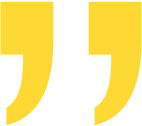
“We keep an iron fist on the list...our job is all about integrity.”
– Scott, home inspector
This discovery grabbed our attention. However, with further research, we found out that Liberty Mutual used Dwellbeing to gather home information to better assess their insurance rate. In the age of data privacy, my team thought this could be a down point for many users. We also discussed with our client about strategies that could differentiate Homebuddy and Dwellbeing. Our client didn’t see it as a threat because he believed honesty and sincerity would help Homebuddy stand out in the market.
We found out:
Users didn’t seem to know the difference between home repairs and preventive home maintenance. A majority of users didn’t know the benefit of preventive maintenance such as changing the air filter and cleaning the dryer vent. Most of them only started to care about preventative maintenance after something broke.

“When I bought my house I wanted to keep it in the best condition possible—but I had little to no experience with those things.”
– Michael, 35, homeowner
According to the demographic survey we handed out, 5 out of 7 users had a household income of over 100k. However, a majority of users expressed that money was the major reason they didn’t always do preventive maintenance. Apart from money, time was another reason they refrained from doing home maintenance. All the users we interviewed worked full time and had busy schedules. Some of them had the awful experience of having to go back and forth to get the right materials for one simple task.

“I only know when it’s not working.”
– Gina, 27, apartment owner
We found out:Users valued guidance with choosing between DIY vs. hiring a professional. Not everyone was wise in making decisions. Users shared some “DIY gone bad” storied with us as well as “should’ve done it myself if I’d known it was that easy” stories. A majority of users often did extensive Google research before making a decision.

“If you want to keep your marriage, hire someone else.”
– Cornelia, 36, house owner
Users preferred options. Users liked to see a service calendar online and pick a time slot of their choice. The traditional “call a professional” had caused many pain points for the users. It could take weeks for someone to come in and fix the dryer. Users also liked to see a list of professionals with detailed reviews and ratings. This again validated our assumption that reviews were important to building trust.

“I use Google calendar to schedule everything in my day.”
– Andrea, 34, single family home owner
After brainstorming and sketching, we created 3 concepts that aimed to provide diverged solutions to our problem. Designing for the two types of users, we also incorporated Ryan’s monetization ideas so that our product was feasible. Our goals for testing were to understand the user’s motivation behind doing home maintenance and their preferred ways of finding a professional. Each concept was set to tackle different user behaviors.





Based on the feedback we got from users we thought that none of the concepts were strong enough to be built to a complete product. So we decided to take features from each concept that tested well and converge them. I came up with the idea of using a dashboard as an agent to host all the features, a dashboard that also had the ability to grow in the future.
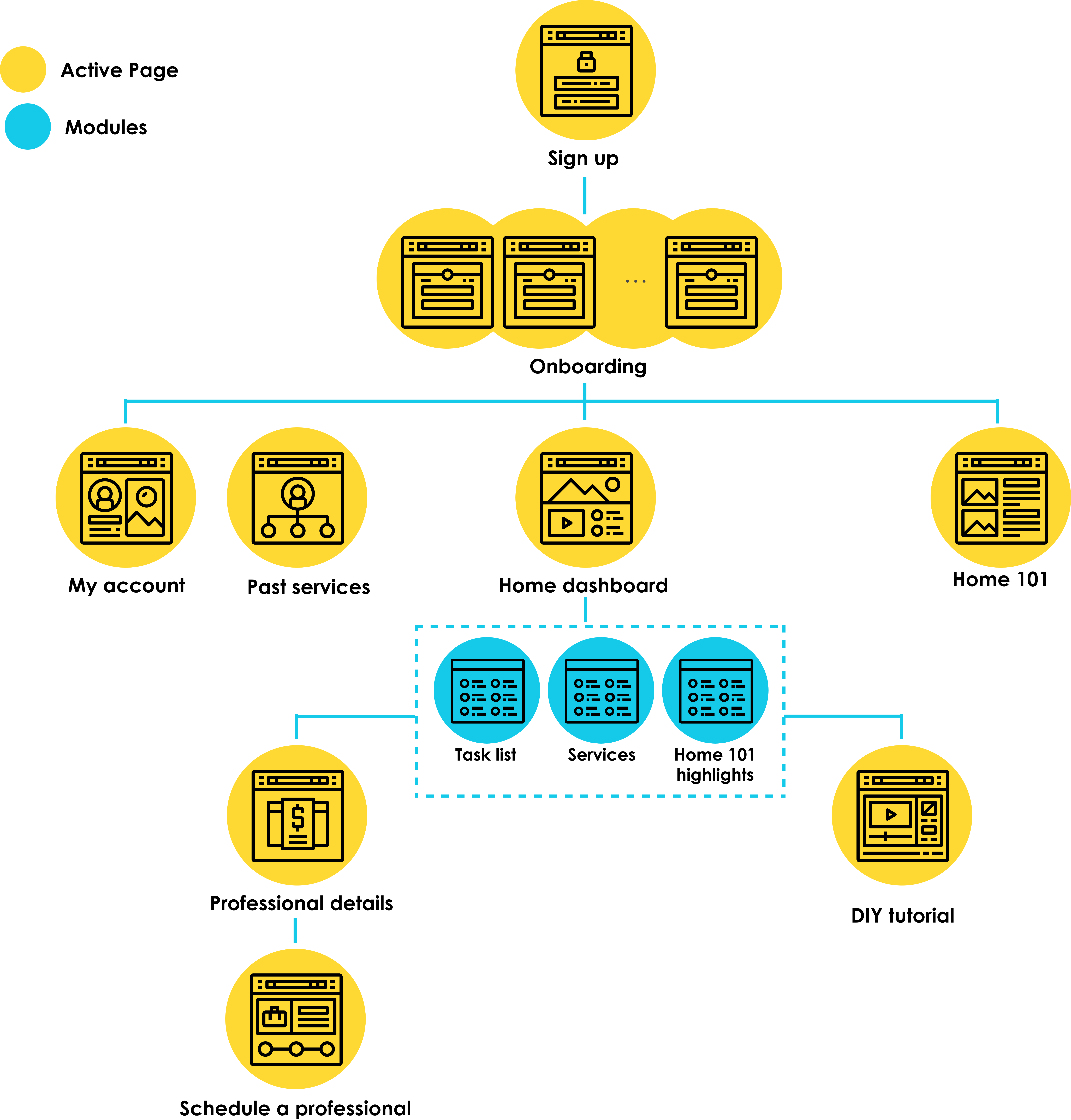
Even though we only had 3 weeks to work on this project, my team and I spent over 800 hours on creating a better digital solution for Homebuddy. I’m extremely proud of what we accomplished. Seeing our client implementing our design to his current platform felt very rewarding. However, because of the uncertainty around the early stage of a startup, we weren’t able to well-tailor our design to Ryan’s growing business plan. The users we tested were all very excited about Ryan’s product. They provided us with insights on how Homebuddy could be profitable by being the expert that knows the uniqueness of their home as well as the “buddy” that made them feel they were in control of their home. We saw them by focusing on those areas Homebuddy will stand out from its competitors.
We mapped out future recommendations and considerations for our client to move the product forward.
Homebuddy should allow users to check off and manage their maintenance task list. It was important to design for the edge-use cases and think about different scenarios. We needed to consider that users need to push off certain tasks or they’d done some tasks already. Our product should give users the flexibility of managing their home maintenance tasks.
As we gathered more domain knowledge throughout the project we realized that the type of appliances would influence the maintenance plan. However, packing all the specifications into the initial onboarding survey might be too overwhelming for users. We thought that Homebuddy could include a secondary onboarding survey in the dashboard which would enable users with further customization. LinkedIn was a great example to look at.
We saw the importance of having good content. And we wanted homebuddy clients to put in more thought into generating helpful and educational content. By incorporating curation and search functions, the home 101 section could be a powerful tool for the homeowners.